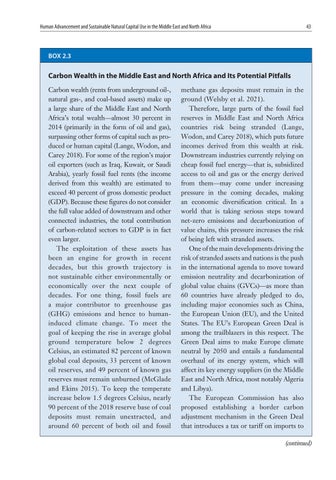Human Advancement and Sustainable Natural Capital Use in the Middle East and North Africa
43
BOX 2.3
Carbon Wealth in the Middle East and North Africa and Its Potential Pitfalls Carbon wealth (rents from underground oil-, natural gas-, and coal-based assets) make up a large share of the Middle East and North Africa’s total wealth—almost 30 percent in 2014 (primarily in the form of oil and gas), surpassing other forms of capital such as produced or human capital (Lange, Wodon, and Carey 2018). For some of the region’s major oil exporters (such as Iraq, Kuwait, or Saudi Arabia), yearly fossil fuel rents (the income derived from this wealth) are estimated to exceed 40 percent of gross domestic product (GDP). Because these figures do not consider the full value added of downstream and other connected industries, the total contribution of carbon-related sectors to GDP is in fact even larger. The exploitation of these assets has been an engine for growth in recent decades, but this growth trajectory is not sustainable either environmentally or economically over the next couple of decades. For one thing, fossil fuels are a major contributor to greenhouse gas (GHG) emissions and hence to humaninduced climate change. To meet the goal of keeping the rise in average global ground temperature below 2 degrees Celsius, an estimated 82 percent of known global coal deposits, 33 percent of known oil reserves, and 49 percent of known gas reserves must remain unburned (McGlade and Ekins 2015). To keep the temperate increase below 1.5 degrees Celsius, nearly 90 percent of the 2018 reserve base of coal deposits must remain unextracted, and around 60 percent of both oil and fossil
methane gas deposits must remain in the ground (Welsby et al. 2021). Therefore, large parts of the fossil fuel reserves in Middle East and North Africa countries risk being stranded (Lange, Wodon, and Carey 2018), which puts future incomes derived from this wealth at risk. Downstream industries currently relying on cheap fossil fuel energy—that is, subsidized access to oil and gas or the energy derived from them—may come under increasing pressure in the coming decades, making an economic diversification critical. In a world that is taking serious steps toward net-zero emissions and decarbonization of value chains, this pressure increases the risk of being left with stranded assets. One of the main developments driving the risk of stranded assets and nations is the push in the international agenda to move toward emission neutrality and decarbonization of global value chains (GVCs)—as more than 60 countries have already pledged to do, including major economies such as China, the European Union (EU), and the United States. The EU’s European Green Deal is among the trailblazers in this respect. The Green Deal aims to make Europe climate neutral by 2050 and entails a fundamental overhaul of its energy system, which will affect its key energy suppliers (in the Middle East and North Africa, most notably Algeria and Libya). The European Commission has also proposed establishing a border carbon adjustment mechanism in the Green Deal that introduces a tax or tariff on imports to (continued)






